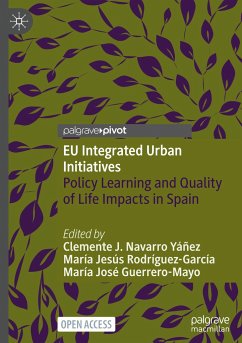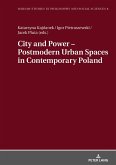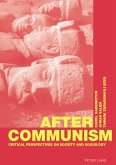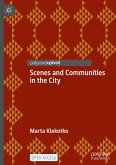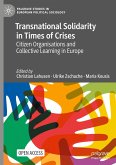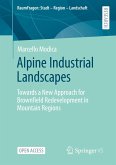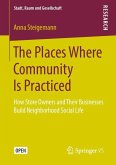EU Integrated Urban Initiatives
Policy Learning and Quality of Life Impacts in Spain
Herausgegeben:Navarro Yáñez, Clemente J.; Rodríguez-García, María Jesús; Guerrero-Mayo, María José
EU Integrated Urban Initiatives
Policy Learning and Quality of Life Impacts in Spain
Herausgegeben:Navarro Yáñez, Clemente J.; Rodríguez-García, María Jesús; Guerrero-Mayo, María José
- Gebundenes Buch
- Merkliste
- Auf die Merkliste
- Bewerten Bewerten
- Teilen
- Produkt teilen
- Produkterinnerung
- Produkterinnerung
This open access book presents a unique interdiscplinary analysis of urban projects promoted by the EU from a comparative perspective This book presents cross-sectional and cross-time analyses at the territorial level targeted by these initiatives focusing on the design, theory and impacts of urban projects developed under the framework of initiatives promoted by the European Union. The book includes a new methodology to analyse the design and theory of urban plans (the comparative urban portfolio analysis) and quasi-experimental strategies to perform impact assessment at the neighbourhood…mehr
Andere Kunden interessierten sich auch für
![City and Power ¿ Postmodern Urban Spaces in Contemporary Poland City and Power ¿ Postmodern Urban Spaces in Contemporary Poland]() City and Power ¿ Postmodern Urban Spaces in Contemporary Poland38,10 €
City and Power ¿ Postmodern Urban Spaces in Contemporary Poland38,10 €![Global Change and Human Mobility Global Change and Human Mobility]() Global Change and Human Mobility38,99 €
Global Change and Human Mobility38,99 €![After Communism After Communism]() After Communism66,95 €
After Communism66,95 €![Scenes and Communities in the City Scenes and Communities in the City]() Marta KlekotkoScenes and Communities in the City38,99 €
Marta KlekotkoScenes and Communities in the City38,99 €![Transnational Solidarity in Times of Crises Transnational Solidarity in Times of Crises]() Transnational Solidarity in Times of Crises38,99 €
Transnational Solidarity in Times of Crises38,99 €![Alpine Industrial Landscapes Alpine Industrial Landscapes]() Marcello ModicaAlpine Industrial Landscapes38,99 €
Marcello ModicaAlpine Industrial Landscapes38,99 €![The Places Where Community Is Practiced The Places Where Community Is Practiced]() Anna SteigemannThe Places Where Community Is Practiced38,99 €
Anna SteigemannThe Places Where Community Is Practiced38,99 €-
-
-
This open access book presents a unique interdiscplinary analysis of urban projects promoted by the EU from a comparative perspective This book presents cross-sectional and cross-time analyses at the territorial level targeted by these initiatives focusing on the design, theory and impacts of urban projects developed under the framework of initiatives promoted by the European Union. The book includes a new methodology to analyse the design and theory of urban plans (the comparative urban portfolio analysis) and quasi-experimental strategies to perform impact assessment at the neighbourhood level (the territorial target of those initiatives). Although empirical analyses focus on examples in Spain, the resulting analytical and methodological outcomes of these studies can be applied in a broader context to analyse integral urban policies in other countries.
Produktdetails
- Produktdetails
- Verlag: Palgrave Macmillan / Spanish Research Agency / Springer International Publishing / Springer, Berlin
- Artikelnr. des Verlages: 978-3-031-20884-3
- 1st ed. 2023
- Seitenzahl: 240
- Erscheinungstermin: 15. Februar 2023
- Englisch
- Abmessung: 216mm x 153mm x 18mm
- Gewicht: 428g
- ISBN-13: 9783031208843
- ISBN-10: 3031208846
- Artikelnr.: 65983971
- Herstellerkennzeichnung
- Springer-Verlag GmbH
- Tiergartenstr. 17
- 69121 Heidelberg
- ProductSafety@springernature.com
- Verlag: Palgrave Macmillan / Spanish Research Agency / Springer International Publishing / Springer, Berlin
- Artikelnr. des Verlages: 978-3-031-20884-3
- 1st ed. 2023
- Seitenzahl: 240
- Erscheinungstermin: 15. Februar 2023
- Englisch
- Abmessung: 216mm x 153mm x 18mm
- Gewicht: 428g
- ISBN-13: 9783031208843
- ISBN-10: 3031208846
- Artikelnr.: 65983971
- Herstellerkennzeichnung
- Springer-Verlag GmbH
- Tiergartenstr. 17
- 69121 Heidelberg
- ProductSafety@springernature.com
Clemente J. Navarro. Professor, Department of Sociology, Pablo de Olavide University (Seville, Spain). Head of the Centre for Sociology and Urban Policies-The Urban Governance Lab. Jean Monnet Chair in European Urban Policies (European Commission). President of the Research Committee on Community Research-International Sociological Association. Founder of the Spanish Network on Urban Sociology (RESU), the current research group of Urban Sociology in the Spanish Federation of Sociology. He teaches urban sociology and research methods. His research activities focus on urban sociology, policies, and governance from a comparative perspective. Current projects as a leading researcher: EUrPol (European Commission), URBAN-IMPACTS (Government of Spain and EDRF-European Union), COVID-19 Impacts on Smart Specialization Strategies (European Commission). María J. Rodríguez-García. Associate Professor, Department of Sociology, Pablo de Olavide University (Seville, Spain). Member of the Centre for Local Political Sociology and Policies-The Urban Governance Lab. She teaches on welfare state and policies. Her research activities focus on comparative analysis of local welfare systems and gender-friendly policies. She has been visiting researcher at The University of Chicago or Istitute de Sciences du Politique (CNRS). Board member of the RC03 Community Research, International Sociological Association. Member of the research team of the Jean Monnet Chair in European Urban Policies. Current project as a leading researcher: local welfare systems and defamilisation. Urban policies and household strategies (Regional Department of Research and Science. Government of Andalusia). María José Guerrero-Mayo. Associate Professor, Department of Sociology, Pablo de Olavide University (Seville, Spain). Member of the Centre for Local Political Sociology and Policies-The Urban Governance Lab. He teaches public policies analysis and evaluation. Her research activities focus on public policy analysis and evaluation. He has been in charge of the Department of Evaluation at the Regional Institute for Regional Development (Sevilla University). She has carried out evaluative analysis about European, National, Regional and Local Policies. Member of the research team of the Jean Monnet Chair in European Urban Policies. Member of the Execitive Board of the Andalusian Association of Sociology.
Chapter 1. Introduction: EU urban initiatives as integrated multi-level policy mixes. Policy levels, policy dimensions and added values of integrated local strategies from a comparative perspective. By Clemente J. Navarro.- Part I: Better urban policies or added value I: the practice and learnings on the policy integration strategy at the local level.- Chapter 2. The nature and the policy added values of EU urban integrated development initiatives: research issues and strategies. By María Jesús Rodríguez-García, Clemente J. Navarro and María José Guerrero-Mayo.- Chapter 3. Evaluating the design of integrated urban development initiatives: evaluability, plan quality and planning learning processes. By María José Guerrero-Mayo and María Jesús Rodríguez-García.- Chapter 4. The agenda of urban sustainable development initiatives: challenges, goals and actions across policy areas. By María Rosa Herrera-Gutiérrez, Lucía Muñoz García and Enrique Pastor Seller.- Chapter 5. The integrated strategy as urban policy innovation proposed by the EU: do cities apply it?. By Enrique Pastor-Seller, María José Dorado-Rubín, María José Guerrero-Mayo and Clemente J. Navarro.- Chapter 6. Opening the black box of integrated urban development strategies: on causal mechanisms and policy theories. By Clemente J. Navarro and María Jesús Rodríguez-García.- Part II: Better spaces to live or the added value II: the impacts of the policy integrated strategy on neighbourhoods and residents.- Chapter 7. The impact of EU integrated urban development initiatives: research strategies beyond 'good practices'. By Alicia Domínguez-González and Clemente J. Navarro.- Chapter 8. The impact of the URBAN Initiative: on residential mobility and 'contextual exposure' to EU integrated urban development strategies. By Clemente J. Navarro, Manuel Fernández-García and Alicia Domínguez-González.- Chapter 9. The impact of the URBANA Initiative: socioeconomic conditions, self-perceived health and quality of the built environment. A time-trend analysis of repeated cross-sectional data. By Ángel Ramón Zapata-Moya and Clemente J. Navarro Yáñez.-Chapter 10. 'Cultural buzz' on the neighbourhood: the impact of the URBAN I Initiative on cultural consumption opportunities. By Cristina Mateos Mora and Clemente J. Navarro Yáñez.-Chapter 11. The 'historical city centre' question. How have the historical centres of major cities changed after the intervention of the URBAN I Initiative?. By Manuel Fernández-García, Francesca Donati and Clemente J. Navarro.- Chapter 12. Conclusions: Policy evidence about the added values of EU integrated urban initiatives as local policy mixes and multi-scalar comparative research. By Clemente J. Navarro, María Jesús Rodríguez-García and María José Guerrero-Mayo.
Chapter 1. Introduction: EU urban initiatives as integrated multi-level policy mixes. Policy levels, policy dimensions and added values of integrated local strategies from a comparative perspective. By Clemente J. Navarro.- Part I: Better urban policies or added value I: the practice and learnings on the policy integration strategy at the local level.- Chapter 2. The nature and the policy added values of EU urban integrated development initiatives: research issues and strategies. By María Jesús Rodríguez-García, Clemente J. Navarro and María José Guerrero-Mayo.- Chapter 3. Evaluating the design of integrated urban development initiatives: evaluability, plan quality and planning learning processes. By María José Guerrero-Mayo and María Jesús Rodríguez-García.- Chapter 4. The agenda of urban sustainable development initiatives: challenges, goals and actions across policy areas. By María Rosa Herrera-Gutiérrez, Lucía Muñoz García and Enrique Pastor Seller.- Chapter 5. The integrated strategy as urban policy innovation proposed by the EU: do cities apply it?. By Enrique Pastor-Seller, María José Dorado-Rubín, María José Guerrero-Mayo and Clemente J. Navarro.- Chapter 6. Opening the black box of integrated urban development strategies: on causal mechanisms and policy theories. By Clemente J. Navarro and María Jesús Rodríguez-García.- Part II: Better spaces to live or the added value II: the impacts of the policy integrated strategy on neighbourhoods and residents.- Chapter 7. The impact of EU integrated urban development initiatives: research strategies beyond 'good practices'. By Alicia Domínguez-González and Clemente J. Navarro.- Chapter 8. The impact of the URBAN Initiative: on residential mobility and 'contextual exposure' to EU integrated urban development strategies. By Clemente J. Navarro, Manuel Fernández-García and Alicia Domínguez-González.- Chapter 9. The impact of the URBANA Initiative: socioeconomic conditions, self-perceived health and quality of the built environment. A time-trend analysis of repeated cross-sectional data. By Ángel Ramón Zapata-Moya and Clemente J. Navarro Yáñez.-Chapter 10. 'Cultural buzz' on the neighbourhood: the impact of the URBAN I Initiative on cultural consumption opportunities. By Cristina Mateos Mora and Clemente J. Navarro Yáñez.-Chapter 11. The 'historical city centre' question. How have the historical centres of major cities changed after the intervention of the URBAN I Initiative?. By Manuel Fernández-García, Francesca Donati and Clemente J. Navarro.- Chapter 12. Conclusions: Policy evidence about the added values of EU integrated urban initiatives as local policy mixes and multi-scalar comparative research. By Clemente J. Navarro, María Jesús Rodríguez-García and María José Guerrero-Mayo.

